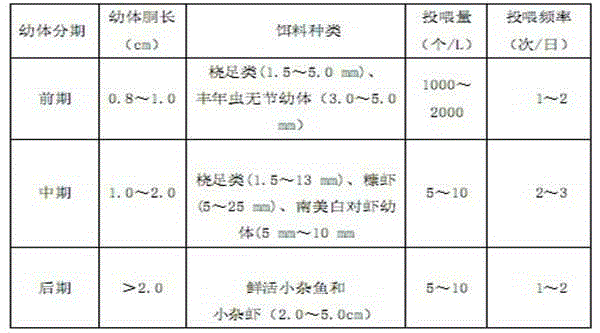Method for artificially breeding sepia lycidas gray
An artificial and artificial technology for the squid, which is applied in the field of artificial seedling raising of the squid, can solve the problems that there are no reports on the artificial breeding of squid, and there are not many studies on the squid, and is suitable for large-scale promotion, easy to breed and grow. quick effect
- Summary
- Abstract
- Description
- Claims
- Application Information
AI Technical Summary
Problems solved by technology
Method used
Image
Examples
Embodiment 1
[0027] A kind of method for artificial seedling cultivation of squid of the present invention specifically comprises the following steps:
[0028] 1. Parental cultivation
[0029] (1) Source and transportation of parent
[0030] From mid-March to late April, small-scale trawls were used to catch spawning and migratory groups in the natural sea area of Zhao'an County, Zhangzhou City, Fujian Province. Select the complete body shape, and put the harmless parents into the device filled with seawater and oxygenated for temporary raising, and send them to the cement pool for temporary raising as soon as possible. When transporting, it is equipped with 2.0×1.5.×1.0m 3 The minivan with nylon canvas is equipped with seawater with a temperature of 14-25 and a salinity of 28-30, and is oxygenated. The transportation time is 0.5h, and the average transportation survival rate is 95.26%. Once inkjet individuals are found, the ink should be removed immediately or the water in the whol...
Embodiment 2
[0079] Same as Example 1, the distinguishing features are: (1) broodstock cultivation water temperature 14°C, salinity 28, dissolved oxygen 10mg / L, pH 7.81; (2) spawning water temperature 16.4°C, salinity 28; (3 ) The hatching salinity is 25, the temperature is 21 °C, and the average hatching time is 34 days; (4) The seedling cultivation temperature is 21 °C, the salinity is 23, and the pH is 7.81; 1.5cm, the body width is 1.2cm, and when the body weight is 0.5g, the seedling cultivation is completed. (6) The distance between the fixed ropes is 80cm. The upper end of the ovipositor is fixed on the fixed rope, and the lower end is tied with a sinker weighing 0.1-0.2kg. -5cm gap, the above-mentioned egg attaching device is a polyethylene mesh with a mesh size of 25-30mm and a nylon rope with a diameter of 8mm-12mm. The polyethylene mesh or nylon rope is uniformly hung on each fixed rope, and the polyethylene mesh is suspended. The fixed rope and the fixed rope hanging the nylon...
Embodiment 3
[0081] Same as Example 1, its distinguishing features are: (1) broodstock cultivation water temperature 25°C, salinity 30, dissolved oxygen 12.50 mg / L, pH 8.04; (2) spawning water temperature 25.0°C, salinity 30 (3) The hatching salinity is 30, the temperature is 27°C, and the average hatching time is 24 days; (4) The seedling cultivation temperature is 27°C, the salinity is 30, and the pH is 8.04; (5) When the seedlings are 2.5cm in length, When the length of the body is 1.4cm, the width of the body is 1.1cm, and the body weight is 0.4g, the seedling cultivation is completed; (6) Move the hatched seedlings to the seedling pool, and feed 1.5-5mm copepods in the early stage, and the bait density is 2 / mL; in the mid-term, feed 5-25mm mysis shrimp with a bait density of 8 / L; in the later stage, feed fresh and live small miscellaneous fish and 2.0-5.0cm small miscellaneous shrimp.
PUM
 Login to View More
Login to View More Abstract
Description
Claims
Application Information
 Login to View More
Login to View More - R&D
- Intellectual Property
- Life Sciences
- Materials
- Tech Scout
- Unparalleled Data Quality
- Higher Quality Content
- 60% Fewer Hallucinations
Browse by: Latest US Patents, China's latest patents, Technical Efficacy Thesaurus, Application Domain, Technology Topic, Popular Technical Reports.
© 2025 PatSnap. All rights reserved.Legal|Privacy policy|Modern Slavery Act Transparency Statement|Sitemap|About US| Contact US: help@patsnap.com

